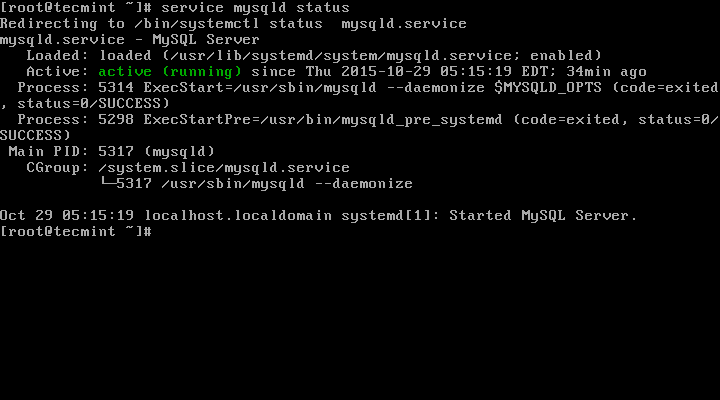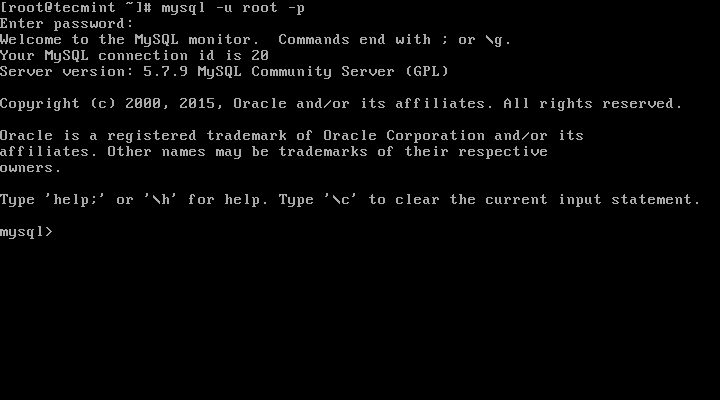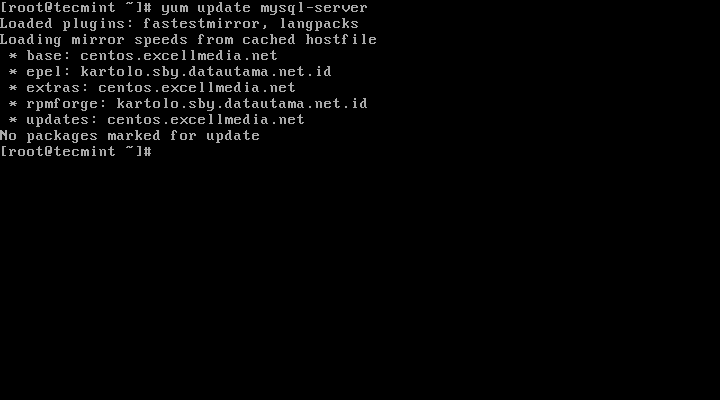How to install Mysql in the CentOS
This article will walk through you the process of installing and updating latest MySQL 5.7.9 version onRHEL/CentOS 7/6/5 and Fedora 23/22/21 using MySQL Yum repository via YUM utility.
Step 1: Adding the MySQL Yum Repository
1. We will use official MySQL Yum software repository, which will provides RPM packages for installing the latest version of MySQL server, client, MySQL Utilities, MySQL Workbench, Connector/ODBC, and Connector/Python for the RHEL/CentOS 7/6/5 and Fedora 23-21.
Important: These instructions only works on fresh installation of MySQL on the server, if there is already a MySQL installed using a third-party-distributed RPM package, then I recommend you to upgrade or replace the installed MySQL package using the MySQL Yum Repository”.
Before Upgrading or Replacing old MySQL package, don’t forget to take all important databases backup and configuration files.
2. Now download and add the following MySQL Yum repository to your respective Linux distribution system’s repository list to install the latest version of MySQL (i.e. 5.7.9 released on 21 October 2015).
--------------- On RHEL/CentOS 7 ---------------
# wget http://dev.mysql.com/get/mysql57-community-release-el7-7.noarch.rpm
--------------- On RHEL/CentOS 6 ---------------
# wget http://dev.mysql.com/get/mysql57-community-release-el6-7.noarch.rpm
--------------- On RHEL/CentOS 5 ---------------
# wget http://dev.mysql.com/get/mysql57-community-release-el5-7.noarch.rpm
--------------- On Fedora 23 ---------------
# wget http://dev.mysql.com/get/mysql57-community-release-fc23-7.noarch.rpm
--------------- On Fedora 22 ---------------
# wget http://dev.mysql.com/get/mysql57-community-release-fc22-7.noarch.rpm
--------------- On Fedora 21 ---------------
# wget http://dev.mysql.com/get/mysql57-community-release-fc21-7.noarch.rpm
3. After downloading the package for your Linux platform, now install the downloaded package with the following command.
--------------- On RHEL/CentOS 7 ---------------
# yum localinstall mysql57-community-release-el7-7.noarch.rpm
--------------- On RHEL/CentOS 6 ---------------
# yum localinstall mysql57-community-release-el6-7.noarch.rpm
--------------- On RHEL/CentOS 5 ---------------
# yum localinstall mysql57-community-release-el5-7.noarch.rpm
--------------- On Fedora 23 ---------------
# dnf localinstall mysql57-community-release-fc23-7.noarch.rpm
--------------- On Fedora 22 ---------------
# dnf localinstall mysql57-community-release-fc22-7.noarch.rpm
--------------- On Fedora 21 ---------------
# yum localinstall mysql57-community-release-fc21-7.noarch.rpm
The above installation command adds the MySQL Yum repository to system’s repository list and downloads the GnuPG key to verify the integrity of the packages.
4. You can verify that the MySQL Yum repository has been added successfully by using following command.
# yum repolist enabled | grep "mysql.*-community.*"
# dnf repolist enabled | grep "mysql.*-community.*" [On Fedora 22+ versions]

Verify MySQL Yum Repository
Step 2: Installing Latest MySQL Version
5. Install latest version of MySQL (currently 5.7) using the following command.
# yum install mysql-community-server
# dnf install mysql-community-server [On Fedora 22+ versions]
The above command installs all the needed packages for MySQL server mysql-community-server, mysql-community-client, mysql-community-common and mysql-community-libs.
Step 3: Installing MySQL Release Series
6. You can also install different MySQL version using different sub-repositories of MySQL Community Server. The sub-repository for the recent MySQL series (currently MySQL 5.7) is activated by default, and the sub-repositories for all other versions (for example, the MySQL 5.6 or 5.5 series) are deactivated by default.
To install specific version from specific sub-repository, you can use --enable or --disable options usingyum-config-manager or dnf config-manager as shown:
# yum-config-manager --disable mysql57-community
# yum-config-manager --enable mysql56-community
------------------ Fedora 22+ Versions ------------------
# dnf config-manager --disable mysql57-community
# dnf config-manager --enable mysql56-community
Step 4: Starting the MySQL Server
7. After successful installation of MySQL, it’s time to start the MySQL server with the following command:
# service mysqld start
You can verify the status of the MySQL server with the help of following command.
# service mysqld status
This is the sample output of running MySQL under my CentOS 7 box.
Redirecting to /bin/systemctl status mysqld.service
mysqld.service - MySQL Server
Loaded: loaded (/usr/lib/systemd/system/mysqld.service; enabled)
Active: active (running) since Thu 2015-10-29 05:15:19 EDT; 4min 5s ago
Process: 5314 ExecStart=/usr/sbin/mysqld --daemonize $MYSQLD_OPTS (code=exited, status=0/SUCCESS)
Process: 5298 ExecStartPre=/usr/bin/mysqld_pre_systemd (code=exited, status=0/SUCCESS)
Main PID: 5317 (mysqld)
CGroup: /system.slice/mysqld.service
└─5317 /usr/sbin/mysqld --daemonize Oct 29 05:15:19 localhost.localdomain systemd[1]: Started MySQL Server.

Check Mysql Status
8. Now finally verify the installed MySQL version using following command.
# mysql --version mysql Ver 14.14 Distrib 5.7.9, for Linux (x86_64) using EditLine wrapper

Check MySQL Installed Version
Step 5: Securing the MySQL Installation
9. The command mysql_secure_installation allows you to secure your MySQL installation by performing important settings like setting the root password, removing anonymous users, removing root login, and so on.
# mysql_secure_installation
Now follow the onscreen instructions carefully, for reference see the output of the above command below.
Sample Output
Securing the MySQL server deployment. Enter password for user root: Enter New Root Password VALIDATE PASSWORD PLUGIN can be used to test passwords
and improve security. It checks the strength of password
and allows the users to set only those passwords which are
secure enough. Would you like to setup VALIDATE PASSWORD plugin? Press y|Y for Yes, any other key for No: y There are three levels of password validation policy: LOW Length >= 8
MEDIUM Length >= 8, numeric, mixed case, and special characters
STRONG Length >= 8, numeric, mixed case, special characters and dictionary file Please enter 0 = LOW, 1 = MEDIUM and 2 = STRONG: 2
Using existing password for root. Estimated strength of the password: 50
Change the password for root ? ((Press y|Y for Yes, any other key for No) : y New password: Set New MySQL Password Re-enter new password: Re-enter New MySQL Password Estimated strength of the password: 100
Do you wish to continue with the password provided?(Press y|Y for Yes, any other key for No) : y
By default, a MySQL installation has an anonymous user,
allowing anyone to log into MySQL without having to have
a user account created for them. This is intended only for
testing, and to make the installation go a bit smoother.
You should remove them before moving into a production
environment. Remove anonymous users? (Press y|Y for Yes, any other key for No) : y
Success. Normally, root should only be allowed to connect from
'localhost'. This ensures that someone cannot guess at
the root password from the network. Disallow root login remotely? (Press y|Y for Yes, any other key for No) : y
Success. By default, MySQL comes with a database named 'test' that
anyone can access. This is also intended only for testing,
and should be removed before moving into a production
environment. Remove test database and access to it? (Press y|Y for Yes, any other key for No) : y
- Dropping test database...
Success. - Removing privileges on test database...
Success. Reloading the privilege tables will ensure that all changes
made so far will take effect immediately. Reload privilege tables now? (Press y|Y for Yes, any other key for No) : y
Success. All done!
Step 6: Connecting to MySQL Server
10. Connecting to newly installed MySQL server by providing username and password.
# mysql -u root -p
Sample Output:
Welcome to the MySQL monitor. Commands end with ; or \g.
Your MySQL connection id is 19
Server version: 5.7.9 MySQL Community Server (GPL) Copyright (c) 2000, 2015, Oracle and/or its affiliates. All rights reserved. Oracle is a registered trademark of Oracle Corporation and/or its
affiliates. Other names may be trademarks of their respective
owners. Type 'help;' or '\h' for help. Type '\c' to clear the current input statement.
mysql>

Connect to MySQL Server
Step 7: Updating MySQL with Yum
11. Besides fresh installation, you can also do updates for MySQL products and components with the help of following command.
# yum update mysql-server
# dnf update mysql-server [On Fedora 22+ versions]

Update MySQL Version
When new updates are available for MySQL, it will auto install them, if not you will get a message saying NO packages marked for updates.
That’s it, you’ve successfully installed MySQL 5.7.9 on your system. If you’re having any trouble installing feel free to use our comment section for solutions.
How to install Mysql in the CentOS的更多相关文章
- Install MySQL 5.7 on Fedora 25/24, CentOS/RHEL 7.3/6.8/5.11
MySQL is a relational database management system (RDBMS) that runs as a server providing multi-user ...
- Install MySql on CentOS
Installing & Configuring MySQL Server This Howto will show you how to install MySQL 5.x, start t ...
- How to Install MySQL on CentOS 7
CentOS 7的yum源中貌似没有正常安装mysql时的mysql-sever文件,需要去官网上下载 # wget http://dev.mysql.com/get/mysql-communit ...
- Installing MySQL Server on CentOS
MySQL is an open-source relational database. For those unfamiliar with these terms, a database is wh ...
- linux下安装多个mysql实例(摘自国外:How to create multiple mysql instance in CentOS 6.4 and Red Hat 6.4)
How to create multiple mysql instance in CentOS 6.4 and Red Hat 6.4 from:http://sharadchhetri.com/20 ...
- Mysql 5.7 CentOS 7 安装MHA
Table of Contents 1. MHA简介 1.1. 功能 1.2. MHA切换逻辑 1.3. 工具 2. 环境 2.1. 软件 2.2. 环境 3. Mysql 主从复制 3.1. Mys ...
- Install MySQL on Mac by Homebrew
1. 安装mysql brew update brew install mysql 2. 启动mysql mysql.server start 3. 登录mysql mysql -uroot -p ...
- yum install mysql
rpm -qa|grep -i mysqlmysql-libs-5.1.52-1.1.alios6.1.x86_64mysql-5.1.52-1.1.alios6.1.x86_64mysql-deve ...
- 在OSX狮子(Lion)上安装MYSQL(Install MySQL on Mac OSX)
这篇文章简述了在Mac OSX狮子(Lion)上安装MySQL Community Server最新版本v10.6.7的过程. MySQL是最流行的开源数据库管理系统.首先,从MySQL的下载页面上下 ...
随机推荐
- CSS半透明兼容写法
filter: Alpha(opacity=10); -moz-opacity:0.1; opacity:0.1; 例如: background:#A5CD40; filter: Alpha(opac ...
- Java中看今天是星期几,礼拜几
下面这段代码就能达到目的: Date today = new Date(); Calendar c=Calendar.getInstance(); c.setTime(to ...
- 5种调优Java NIO和NIO.2的方式
Java NIO(New Input/Output)——新的输入/输出API包——是2002年引入到J2SE 1.4里的.Java NIO的目标是提高Java平台上的I/O密集型任务的性能.过了十年, ...
- C#.NET常见问题(FAQ)-如何输出带选项的MessageBox,YESNO
DialogResult dr=MessageBox.Show("确认删除吗?", "提示", MessageBoxButtons.OKCancel); if ...
- 火狐浏览器Firefox不支持alt怎么
因为HTML代码的解析不同,需要把标签文字"alt"换成"title",就可以在FireFox中正常显示了. 如下所示,IE对于alt和title均可以支持 但 ...
- IIS 之 线程池最大线程数
.net4.0,32位机器最大线程数,每核1023个 .net4.0,64位机器最大线程数,每核32768个 .net3.0,最大线程数,每核250个 .net2.0,最大线程数,每核25个 默认的最 ...
- Appium Python 四:怎样获取APP的Package以及Activity
看到一篇很好的博客:[Android测试][随笔]获得App的包名和启动页Activity 除了博客上的方法,我还找到两种方法: 方法一:aapt 前提需要使用SDK Manager.exe 下载 A ...
- 如何设置qt creator的快捷键
如何设置qt creator快捷键 以设置设置edit - select encoding的快捷键为例 1. tools - options - environment - keyborad 2.在搜 ...
- java多线程解决应用挂死的问题
这两天为了定位JBOSS老是挂死的问题,学习了一下JAVA多线程方面的知识,在此总结一下 1.在Java程序中,JVM负责线程的调度.线程调度是指按照特定的机制为多个线程分配CPU的使用权. 调度的模 ...
- JVM中类的卸载机制
类的生命周期 当Sample类被载入.连接和初始化后,它的生命周期就開始了. 当代表Sample类的Class对象不再被引用,即不可触及时,Class对象就会结束生命周期.Sample类在方法区内的数 ...
